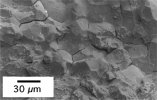- Joined
- Sep 9, 2003
- Messages
- 2,361
I thought I would start a new thread for this since similar questions have been asked in at least two threads and in some e-mails I have received.
........
Steel with carbon contents in excess of the eutectoid are called “hyper-eutectoid”, and require a little more thought and car in their heat treatment than eutectoid steel. When you have all this carbon .80% of it will be used up in the making of the desired phases, but then there will be leftover carbon to deal with. This leftover carbon can be useful or can be a great liability depending on where you put it.


........
Steel with carbon contents in excess of the eutectoid are called “hyper-eutectoid”, and require a little more thought and car in their heat treatment than eutectoid steel. When you have all this carbon .80% of it will be used up in the making of the desired phases, but then there will be leftover carbon to deal with. This leftover carbon can be useful or can be a great liability depending on where you put it.


Last edited:

